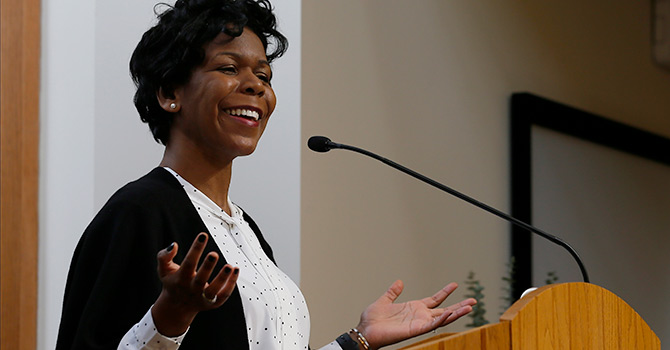We celebrate Women’s History Month in March with reading lists, social media campaigns and presidential proclamations highlighting the accomplishments of women across the centuries. But while we honor progress on many fronts, we must also lament all that remains to be done and undone.
These intertwined realities ring especially true for women in ministry. Many of us serve in congregations under or alongside female pastors, priests, deacons and lay leaders who faithfully proclaim the Lord’s word and work. Movements like #ChurchToo have dragged some of the darkest abuses of women into the light, amplifying the stories and the steps toward healing of survivors. Women preach, teach and testify with bigger platforms and influence than ever.
But tensions, divisions and injustices remain. According to the National Congregations Study, women made up only about 13% of Christian congregational leaders in 2018-19. And that number has likely decreased over the course of the pandemic.
Writing for Faith & Leadership in August 2021, journalist Yonat Shimron noted that the pandemic “has wreaked havoc on working women,” including women clergy.
There are no good figures on the number of clergywomen who have quit as a result of the pandemic, but Christian leaders say the coronavirus has exacerbated the already-stressful lives of women clergy. Many have reported exhaustion, burnout and decision fatigue from the prolonged struggle to care for their congregations, their households and, in many cases, communities combatting racism and anti-Asian violence that arose in response to the illness.
On top of these pandemic stressors, women faith leaders face a continued onslaught — within their own communities and in the headlines — of reminders that they and their ministry may not be taken seriously or viewed as legitimate. Just weeks ago, the Southern Baptist Convention made national news when they kicked out five churches (including Saddleback, a prominent California megachurch) for having female pastors.
The SBC example is extreme, but even women who work in churches and denominations that claim to celebrate their gifts have to (at best) carry this news around with them and (at worst) experience their own slights and judgments.
These issues will not disappear overnight. But I wanted to offer a few ideas on caring for and advocating for the women ministry leaders in our lives. These are practical, concrete actions — many of them drawn from the wisdom shared with Faith & Leadership over the years — that can help female leaders in the church know they are valued and respected.
Don’t assume that you know exactly what the women in ministry in your life need. Instead, invite them to talk freely — and listen to them. In 2019, we interviewed Manuela Casti Yeagley, who served as the lead researcher for a study of early-career clergy in the Flourishing in Ministry project. As Yeagley pointed out, “Church organizations have become more vocal about speaking against sexism, but clergywomen often lament that it mostly happens during big organizational gatherings. These women would like to not just have men onstage telling them what sexism is about but to be invited to speak about their experience in very real terms.”
How often do we extend this kind of invitation? What if we pushed discomfort and defensiveness aside and committed to listening? Yeagley recommended that we “focus on congregational culture, to empower women to speak about what life as a female pastor really looks like.” In what ways can your congregation do this kind of empowering?
Find out what your church and/or denominational policies are on matters like parental leave or time away to care for a sick family member. Unfortunately, you may discover that your church or denomination does not even have these policies in place. As minister-nonprofit leader Susan Rowland Miller and minister-nurse Pamela Graf Short reminded us in 2022, “Many churches and denominational bodies have no parental leave policies. Those that do often have inadequate policies: too little paid leave (6-8 weeks), paid leave at a reduced rate (such as a percentage of full pay), or no paid leave at all (allowing only unpaid time away).”
What systems of support are in place for your ministry leaders who need to step away for a season? Researching the kinds of policies in your context — and acting when what’s available is inadequate — is a way to put your care for all ministry leaders, not just women, into practice.
As Miller and Short put it in their argument for churches’ parental leave policies, “As denominations continue to seek ways to retain women clergy and address the wage gap between male and female clergy in similar positions, birthing a supportive parental leave policy would be a significant advance toward a larger comprehensive strategy.”
Working toward just systems of care for female clergy and leaders is a step toward more fair treatment of clergy and leaders overall.
Increase your church’s funding for spiritual resources for leaders. As we seek to support women leaders, we need to pay attention to their spiritual needs in addition to their physical and economic ones.
A friend of mine recently began a half-time role as a co-pastor of her church. When I asked her what has proved most helpful and encouraging, she told me that the congregation has given her a large allowance covering spiritual direction, conferences, books and other spiritual retreats “to make sure I am taking care of my spiritual needs and not burning out.”
Does your church offer a similar kind of fund? What sorts of resources are available because of it, and could it expand? In the words of one of our “questions to consider” regarding women clergy and the pandemic, “How are you planning for your long-term health and restoration?”
Remind women faith leaders that they belong. Yeagley observed, “The cumulative effect of sexism in the church is that it undermines women’s confidence and ability to trust that they belong in leadership roles.”
An encouraging note or a few words of affirmation after a sermon aren’t going to build that confidence back up single-handedly — but they won’t hurt, either.
You can also remind women leaders that just by standing at the pulpit, just by giving communion or wearing vestments, they are providing a witness and an example to future women leaders. There’s data to back this up: “Research shows that girls who have significant interactions with a female church leader have higher levels of self-confidence and significant advantages in terms of educational and career achievement,” Yeagley said.
She continued: “It’s what we see every week at church that influences how we behave in society and who we see as suitable and not suitable for certain positions.”
What do our people see at church each week? How do we communicate to our sisters in Christ that they are more than just suitable for leadership in the church — that they are called to it, too?
These are practical, concrete actions — many of them drawn from the wisdom shared with Faith & Leadership over the years — that can help female leaders in the church know they are valued and respected.

















